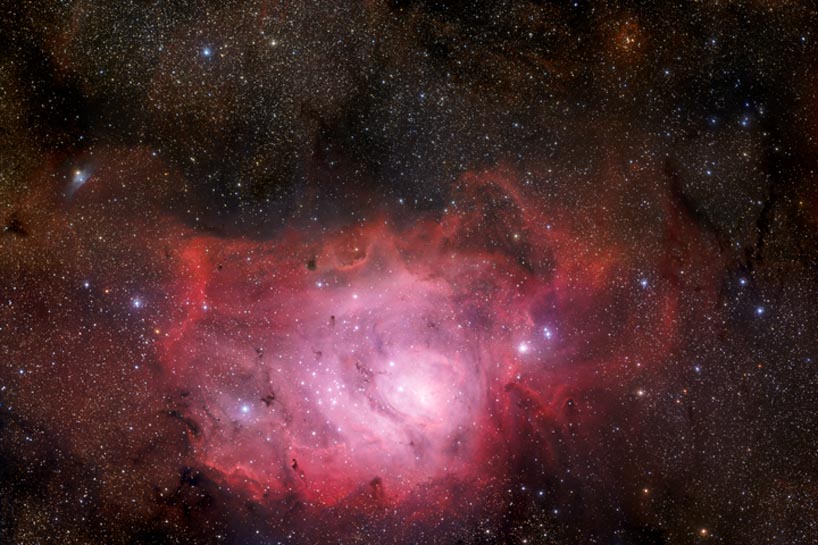
of the Lagoon Nebula
Emission Nebula
RA 18h 3m 36.99s Dec -24° 23' 12.97"
Sagittarius
5000 light years
93.49 x 62.61 arcminutes
North is 0.0° left of vertical
ESO
September 28, 2009
Wide: 1403c 0936 1101w 1101a 1403 Closeup: 1517 1015 1120 1808
ABOUT THIS IMAGE:
The third image of ESO's GigaGalaxy Zoom project has just been released online, completing this eye-opening dive into our galactic home in outstanding fashion. The latest image follows on from views, released over the last two weeks, of the sky as seen with the unaided eye and through an amateur telescope. This third installment provides another breathtaking vista of an astronomical object, this time a 370-million-pixel view of the Lagoon Nebula of the quality and depth needed by professional astronomers in their quest to understand our Universe.
The newly released image extends across a field of view of more than one and a half square degrees - an area eight times larger than that of the full Moon - and was obtained with the Wide Field Imager attached to the MPG/ESO 2.2-meter telescope at the La Silla Observatory in Chile. This 67-million-pixel camera has already created several of ESO's iconic pictures. It is based on images acquired using three different broadband filters (B, V, R) and one narrow-band filter (H-alpha).
The intriguing object depicted here - the Lagoon Nebula - is located four to five thousand light-years away towards the constellation of Sagittarius (the Archer). The nebula is a giant interstellar cloud, 100 light-years across, where stars are forming. The scattered dark patches seen all over the nebula are huge clouds of gas and dust that are collapsing under their own weight and which will soon give birth to clusters of young, glowing stars. Some of the smallest clouds are known as "globules" and the most prominent ones have been catalogued by the astronomer Edward Emerson Barnard.
The Lagoon Nebula hosts the young open stellar cluster known as NGC 6530. This is home for 50 to 100 stars and twinkles in the lower left portion of the nebula. Observations suggest that the cluster is slightly in front of the nebula itself, though still enshrouded by dust, as revealed by reddening of the starlight, an effect that occurs when small dust particles scatter light.
The name of the Lagoon Nebula derives from the wide lagoon-shaped dark lane located in the middle of the nebula that divides it into two glowing sections.
This gorgeous starscape is the last in the series of three huge images featured in the GigaGalaxy Zoom project, launched by ESO as part of the International Year of Astronomy 2009 (IYA2009). Through three giant images, the GigaGalaxy Zoom project reveals the full sky as it appears with the unaided eye from one of the darkest deserts on Earth, then zooms in on a rich region of the Milky Way using an amateur telescope, and finally uses the power of a professional telescope to reveal the details of a famous nebula. In this way, the project links the sky we can all see with the deep, "hidden" cosmos that astronomers study on a daily basis. The wonderful quality of the images is a testament to the splendor of the night sky at ESO's sites in Chile, which are the most productive astronomical observatories in the world.
"The
GigaGalaxy Zoom project's dedicated website has proved very successful,
drawing hundreds of thousands of visitors from all around the world,"
says project coordinator Henri Boffin. "With the trilogy now complete,
viewers will be able to explore a magnificently detailed cosmic environment
on many different scales and take a breathtaking dive into our Milky Way."